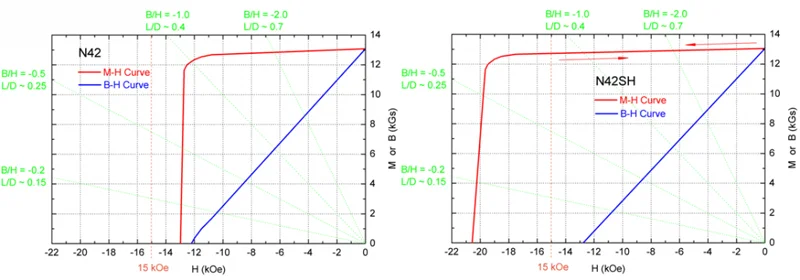Sintered NdFeB Magnet Grades
Generally, the sintered NdFeB magnet grades are strings containing three parts, i.e. “N” + “number” + “letter”. The part “N” is the initial letter of neodymium, meaning it is a sintered neodymium iron boron magnet. So it is constant for all the neodymium magnet grades. The part “number” represents value of maximum energy product (BH)max (in CGS unit). The value varies from 28 to 52. The part “letter” reflects level of intrinsic coercivity Hcj. The levels include “M” (Hcj ≥ 14 kOe), “H” (Hcj ≥ 17 kOe), “SH” (Hcj ≥ 20 kOe), “UH” (Hcj ≥ 25 kOe), “EH” (Hcj ≥ 30 kOe) and “AH” (Hcj ≥ 35 kOe), they are abbreviations for “Medium”, “High”, “Super High”, “Ultra High”, “Extreme High” and “Abnormal High”, respectively. It should also be mentioned that there is a level where the letter is not available or default. In the situation the Hcj is not less than 12 kOe.

Here are two examples for understanding. The NdFeB magnet grade “N45SH” means that the relative sintered NdFeB magnet’s (BH)max is 45 MGOe and its Hcj is above the level of 20 kOe (in CGS unit) or 1592 kA/m (in SI unit). The magnet grade “N52” with default "letter" part means that the relative sintered NdFeB magnet’s (BH)max is 52 MGOe and its Hcj is above the level of 12 kOe or 955 kA/m.
So what is the difference between N35 and N52 magnets? The key difference is that their (BH)max are 35 MGOe and 52 MGOe, respectively. As a permanent magnet’s remanence Br is closely linked to its (BH)max, it also means that the N35 magnet’s Br is lower than that of the N52 magnet, i.e. the latter has higher magnetic flux density. As results, a motor or device using N52 magnet can have higher power and/or can become smaller/lighter than that using N35 magnet.

And what about N42 and N42SH magnets? The key difference is that their Hcj are higher than 12 kOe and 20 kOe, respectively. A permanent magnet with higher coercivity means that it has more ability to resist demagnetization including field demagnetization and thermal demagnetization. When the reverse magnetic field or demagnetizing field reaches 15 kOe (in CGS unit) or 1.5 T (in SI unit), the N42 magnet is nonlinearly demagnetized and is going to be magnetized reversely while the N42SH magnet is linearly demagnetized and its Br can reversibly turn back to the original value when the reverse magnetic field removed. Besides, the maximum working temperature Tw of N42 magnet is 80 ºC while that of N42SH magnet can reach as high as 150 ºC.
